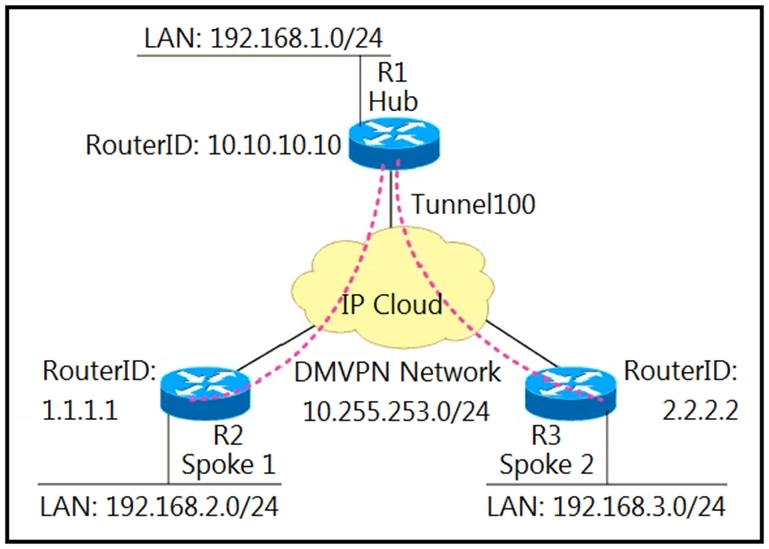

Refer to the exhibit. A network administrator sets up an OSPF routing protocol for a DMVPN network on the hub router.
Which configuration command is required to establish a DMVPN tunnel with multiple spokes?


Refer to the exhibit. A network administrator sets up an OSPF routing protocol for a DMVPN network on the hub router.
Which configuration command is required to establish a DMVPN tunnel with multiple spokes?
To establish a DMVPN tunnel with multiple spokes, the spoke routers need to be configured to handle multiple connections via the 'point-to-multipoint' network type. This configuration is necessary to ensure that the OSPF routing protocol can manage the dynamic nature of multiple adjacencies in the hub-and-spoke topologies characteristic of DMVPN networks. Configuring both spoke routers with 'ip ospf network point-to-multipoint' ensures proper OSPF neighbor relationships and routing updates. Therefore, the correct configuration command is to set 'ip ospf network point-to-multipoint' on both spoke routers.
I lab the given anwer is correct spoke be point to multpoint to that scenario work
the right answer is D. ip ospf network point-to-point on both spoke routers reference : https://learningspace.cisco.com/ Book title : ENARSI - Implementing Cisco Enterprise Advanced Routing and Services - Student Learning Guide, version=1.0.20, page 215 : "In strict hub-and-spoke DMVPNs, you should include the tunnel interface in the OSPF routing process, and configure the tunnel interface as a point-to-multipoint OSPF network type on the hub router, and as a point-to-point network type on the branch routers. In this case, there is no need to elect a DR on the DMVPN subnet."
D is wrong. ospf use dmvpn phase3, all hub and spokes should be point-to-multipoint.
who did you know that is using phase 3
Also OSPF default is point-to-point and we are using multipoint interfaces for each spoke to see each other
given answer is correct according to https://www.grandmetric.com/knowledge-base/design_and_configure/dmvpn-phase-3-single-hub-ospf-spoke-example/
Ahh, again nothing is clear. So. Obviously, the problems are connected EXACTLY with the wrong type of network. I will assume that a point-to-point is configured, and the router needs to establish a neighborhood with two on the same interface, so it blinks(point-to-2point). Second. Why only on one spoke(is this a typical and highly scalable role for a router)? Of course for everyone. According to my logic, it turns out C. P.S.: Does anyone understand how to determine the phase here?
I go here for D, as the point to multpoint is only significant on HUB router. but this in phase 2 on phase 3 also the spokes shoulbe point to multipoint . As the question is pretty ambiguos based on the answers.
When i did the lab of that scenario, by default tunnel interfaces are point to point, leaving by default osp start flapping adjacencies, the hub by desing must be point-to-multipoint, as gre interface also is multipoint. the spoke as are p2p by default on GRE interfaces then start failing as the hello and dead timer of point-to-multipoint and point-to-point are differnt. So the mos correst answer is C as you state.
I believe C is correct
This is how I see it: The issue "Tunnel100 from EXCHANGE to DOWN, Neighbor Down: Adjacency forced to reset" is caused by OSPF default network type p2p. There is a different solution per DMVPN Phase. OSPF network type broadcast is suitable for phase 1 and 2, whereas point-to-multipoint is suitable for Phase3. We can exclude answers with p2p, like A and D. The solution needs to be applied on all spokes, so answer C is fitting best. https://community.cisco.com/t5/routing/help-with-ospf-and-dmvpn/td-p/2107338/page/2 https://networklessons.com/cisco/ccie-routing-switching/dmvpn-phase-1-ospf-routing
https://networklessons.com/cisco/ccie-routing-switching/dmvpn-phase-3-ospf-routing#Point-to-multipoint
we have two neigbors, beacuse is necesary point-to-multipoint
Answer C: this linked helped a lot - https://community.cisco.com/t5/routing/help-with-ospf-and-dmvpn/td-p/2107338
The correct answer is D. Look at the purple lines, this is Hub to Spoke, this is NOT Spoke to Spoke topology. So Option C is definitely not the answer.
C is correct